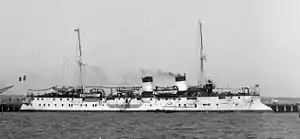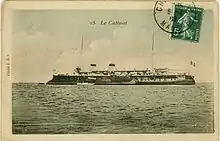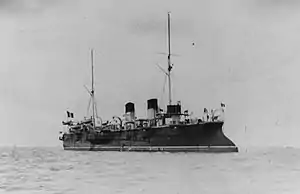Catinat-class cruiser
The Catinat class comprised two protected cruisers of the French Navy built in the early 1890s; the two ships were Catinat and Protet. They were ordered as part of a naval construction program directed at France's rivals, Italy and Germany, particularly after Italy made progress in modernizing its own fleet. The plan was also intended to remedy a deficiency in cruisers that had been revealed during training exercises in the 1880s. As such, the Catinat-class cruisers were intended to operate as fleet scouts and in the French colonial empire. The ships were armed with a main battery of four 164 mm (6.5 in) guns supported by ten 100 mm (3.9 in) guns and they had a top speed of 19.5 to 20 knots (36.1 to 37.0 km/h; 22.4 to 23.0 mph).
 Protet | |
| Class overview | |
|---|---|
| Name: | Catinat class |
| Builders: | |
| Operators: |
|
| Preceded by: | D'Assas class |
| Succeeded by: | D'Entrecasteaux |
| Built: | 1894–1899 |
| In service: | 1898–1911 |
| Completed: | 2 |
| Retired: | 2 |
| General characteristics | |
| Type: | Protected cruiser |
| Displacement: | 4,001–4,048 long tons (4,065–4,113 t) |
| Length: | 98.09 m (321 ft 10 in) pp |
| Beam: | 13.59 m (44 ft 7 in) |
| Draft: | 6.43 m (21 ft 1 in) |
| Installed power: |
|
| Propulsion: | |
| Speed: | 19.5 to 20 knots (36.1 to 37.0 km/h; 22.4 to 23.0 mph) |
| Range: | 6,000 nmi (11,000 km; 6,900 mi) at 10 kn (19 km/h; 12 mph) |
| Complement: | 400 |
| Armament: |
|
| Armor: |
|
Catinat served briefly with the Northern Squadron in 1898 and 1899 before being placed in reserve; thereafter, she and Protet served the entirety of their active careers abroad. Protet was sent to the Pacific in 1899 after being completed, and she remained there through 1905 to protect French interests. Catinat was sent on a brief stint to French Madagascar in 1901 through at least 1902, before returning to France at some point before 1905. Early that year, she was sent to the Pacific to replace her sister ship, remaining there through at least 1908. No records of her activities thereafter survive. That year, Protet was converted into a training ship for the Gunnery School, though she was sold for scrap in 1910. Catinat was discarded the following year.
Design

In the late 1880s, the Italian Regia Marina (Royal Navy) accelerated construction of ships for its fleet and reorganized its most modern ironclad battleships—the Caio Duilio and Italia classes—into a fast squadron suitable for offensive operations. These developments provoked a strong response in the French press. The Budget Committee in the French Chamber of Deputies began to press for a "two-power standard" in 1888, which would see the French fleet enlarged to equal the combined Italian and German fleets, then France's two main rivals on the continent. This initially came to nothing, as the supporters of the Jeune École doctrine called for a fleet largely based on squadrons of torpedo boats to defend the French coasts rather than an expensive fleet of ironclads. This view had significant support in the Chamber of Deputies.[1]
The next year, a war scare with Italy led to further outcry to strengthen the fleet. To compound matters, the visit of a German squadron of four ironclads to Italy confirmed French concerns of a combined Italo-German fleet that would dramatically outnumber their own. Training exercises held in France that year demonstrated that the slower French fleet would be unable to prevent the faster Italian squadron from bombarding the French coast at will, in part because it lacked enough cruisers (and doctrine to use them) to scout for the enemy ships.[2]
To correct the weaknesses of the French fleet, on 22 November 1890, the Superior Council authorized a new construction program directed not at simple parity with the Italian and German fleets, but numerical superiority. In addition to twenty-four new battleships, a total of seventy cruisers were to be built for use in home waters and overseas in the French colonial empire. The Catinat class were ordered to as part of the program, and they were based on the earlier Descartes class.[2][3] The Catinat-class ships were intended to operate in France's overseas colonies.[4]
General characteristics and machinery

The ships of the Catinat class were 98.09 m (321 ft 10 in) long between perpendiculars and 100.20 m (328 ft 9 in) long overall. They had a beam of 13.59 m (44 ft 7 in) and a draft of 6.43 m (21 ft 1 in). Catinat displaced 4,048 long tons (4,113 t), while Protet displaced 4,001 long tons (4,065 t). Protet suffered from stability problems and had to have ballast added, accounting for her greater displacement.[4][5]
Like most French warships of the period, the Catinat-class cruisers' hulls had a pronounced ram bow, tumblehome shape, and a short forecastle deck. Below the waterline, the hulls were covered in a layer of wood and copper sheathing to protect them from biofouling on long voyages overseas. The ships had a minimal superstructure, consisting primarily of a small conning tower and a bridge. They were originally to have been fitted with heavy military masts, but during construction, these were replaced with lighter pole masts with spotting tops for observation and signaling purposes. Their crew numbered 400 officers and enlisted men.[5][6]
The ships' propulsion system consisted of a pair of vertical triple-expansion steam engines driving two screw propellers. Steam was provided by sixteen coal-burning Belleville-type water-tube boilers that were ducted into two funnels. Their machinery was rated to produce 7,000 indicated horsepower (5,200 kW) normally, and up to 9,000 ihp (6,700 kW) using forced draft, for a top speed of 19 knots (35 km/h; 22 mph). In service, both cruisers were capable of 9,500 ihp (7,100 kW) for a speed of 19.5 to 20 knots (36.1 to 37.0 km/h; 22.4 to 23.0 mph). Coal storage amounted to 560 long tons (570 t),[4][5] which allowed them to steam for 6,000 nautical miles (11,000 km; 6,900 mi) at a speed of 10 knots (19 km/h; 12 mph).[7]
Armament and armor
._Pi%C3%A8ce_de_100_de_marine_-_Fonds_Berthel%C3%A9_-_49Fi1270_(cropped).jpg.webp)
The Catinat-class vessels were armed with a main battery of four 164 mm (6.5 in) Modèle 1893 45-caliber guns. They were placed in individual sponsons clustered amidships, two guns per broadside.[5] They were supplied with a variety of shells, including solid, 45 kg (99 lb) cast iron projectiles, and explosive armor-piercing (AP) and semi-armor-piercing (SAP) shells that weighed 54.2 kg (119 lb) and 52.6 kg (116 lb), respectively. The guns fired with a muzzle velocity of 770 to 800 m/s (2,500 to 2,600 ft/s).[8]
The main battery was supported by a secondary battery of ten 100 mm (3.9 in) Modèle 1891 guns, which were carried in a variety of mounts. Two guns fitted with gun shields were placed side-by-side in pivot mounts on the upper deck, four more were in the upper deck forward in casemates. Another pair of guns were in sponsons further aft, and the remaining pair were in pivot mounts on the upper deck aft.[5] The guns fired 14 kg (31 lb) cast iron and 16 kg (35 lb) AP shells with a muzzle velocity of 710 to 740 m/s (2,300 to 2,400 ft/s).[9]
For close-range defense against torpedo boats, they carried ten 47 mm (1.9 in) 3-pounder Hotchkiss guns and four 37 mm (1.5 in) 1-pounder guns, all in individual pivot mounts. They were also armed with two 350 mm (13.8 in) torpedo tubes in their hulls above the waterline. They had a capacity to carry fifty naval mines, which were stored in the compartment for the steering engine. A rail extended aft, through the captain's cabin, to a port in the stern, where the mines could be dropped into the ships' wake.[5]
Armor protection consisted of a curved armor deck that was 30 mm (1.2 in) thick on the flat portion, curving down at the sides, where it increased in thickness to 60 mm (2.4 in). Toward the bow and stern, the deck was reduced slightly to 25 mm (0.98 in). Above the deck, a cellular layer of watertight compartments was intended to contain flooding below the waterline. A light splinter deck covered the propulsion machinery spaces to protect them from shell fragments that penetrated the main armor deck. The gun shields for the deck-mounted 100 mm guns were 50 mm (2 in) thick. The ships had 70 mm (2.8 in) plating on the conning tower.[3]
Construction
| Name | Laid down[5] | Launched[10] | Completed[5] | Shipyard[5] |
|---|---|---|---|---|
| Catinat | February 1894 | 8 October 1896 | 1898 | Société Nouvelle des Forges et Chantiers de la Méditerranée, La Seyne-sur-Mer |
| Protet | March 1896 | 6 July 1898 | February 1899 | Forges et Chantiers de la Gironde, Lormont |
Service history

Catinat was assigned to the Northern Squadron in 1898, where she conducted training exercises with the rest of the unit. During maneuvers that year, she accidentally ran aground, but was not seriously damaged in the incident.[11] She served in the unit for less than a year before being transferred to the reserve fleet. Protet was sent to the Pacific Ocean for a lengthy deployment after her completion in 1899.[13] She helped suppress a fire in the United States in 1900 and protected French interests in Colombia during a conflict in the country in 1901.[14][15] Catinat had been recommissioned and sent abroad by 1901, being stationed in French Madagascar.[16] She operated there at least through 1902.[17]
At some point thereafter, Catinat was recalled home and decommissioned once more. In early 1905, she was recommissioned to relieve Protet, which had also been recalled home that year.[18] Protet was converted into a training ship for gun crews at the Gunnery School in 1908,[19] but served in that capacity for just two years. She was struck from the naval register in 1910 and thereafter broken up.[10] Catinat's career in the Pacific was uneventful, and she remained on station in the region through 1908.[20] She followed her sister ship to the breakers' yard in 1911.[10]
Notes
- Ropp, p. 195.
- Ropp, pp. 195–197.
- Gardiner, pp. 311–312.
- Glennon, p. 837.
- Gardiner, p. 312.
- Glennon, pp. 837–838.
- Garbett 1904, p. 563.
- Friedman, p. 221.
- Friedman, p. 225.
- Gardiner & Gray, p. 193.
- Leyland, pp. 213–215.
- Service Performed, p. 299.
- Hay, p. 478.
- South America, p. 617.
- Jordan & Caresse, p. 219.
- Brassey 1902, p. 52.
- Garbett 1905, pp. 321–322.
- Garbett 1908, p. 864.
- Garbett 1908, p. 863.
References
| Wikimedia Commons has media related to Catinat class cruisers. |
- Brassey, Thomas A. (1902). "Chapter III: Relative Strength". The Naval Annual. Portsmouth: J. Griffin & Co.: 47–55. OCLC 496786828.
- Friedman, Norman (2011). Naval Weapons of World War One: Guns, Torpedoes, Mines and ASW Weapons of All Nations; An Illustrated Directory. Annapolis: Naval Institute Press. ISBN 978-1-84832-100-7.
- Garbett, H., ed. (May 1904). "Naval Notes: France". Journal of the Royal United Service Institution. London: J. J. Keliher & Co. XLVIII (315): 560–566. OCLC 1077860366.
- Garbett, H., ed. (March 1905). "Naval Notes: France". Journal of the Royal United Service Institution. London: J. J. Keliher & Co. XLIX (325): 321–325. OCLC 1077860366.
- Garbett, H., ed. (June 1908). "Naval Notes: France". Journal of the Royal United Service Institution. London: J. J. Keliher & Co. LII (364): 861–864. OCLC 1077860366.
- Gardiner, Robert, ed. (1979). Conway's All the World's Fighting Ships 1860–1905. London: Conway Maritime Press. ISBN 978-0-85177-133-5.
- Gardiner, Robert & Gray, Randal, eds. (1985). Conway's All the World's Fighting Ships: 1906–1921. Annapolis: Naval Institute Press. ISBN 978-0-87021-907-8.
- Glennon, J. H., ed. (1894). "The Decennial Programme for Naval Construction in France". Proceedings of the United States Naval Institute. Annapolis: Naval Institute Press. XX (4): 832–838.
- Hay, John (1902). "Assistance Rendered by French Cruiser Protet in Extinguishing a Fire in San Francisco Harbor". Papers Relating to the Foreign Relations of the United States with the Annual Message of the President. Washington D.C.: Government Printing Office: 478.
- Jordan, John & Caresse, Philippe (2017). French Battleships of World War One. Annapolis: Naval Institute Press. ISBN 978-1-59114-639-1.
- Leyland, John (1899). Brassey, Thomas A. (ed.). "Chapter IX: Foreign Naval Manoeuvres". The Naval Annual. Portsmouth: J. Griffin & Co.: 210–218. OCLC 496786828.
- "Naval Notes: France". Journal of the Royal United Service Institution. London: J. J. Keliher & Co. XLII (251): 190–193. 1899. OCLC 1077860366.
- Ropp, Theodore (1987). Roberts, Stephen S. (ed.). The Development of a Modern Navy: French Naval Policy, 1871–1904. Annapolis: Naval Institute Press. ISBN 978-0-87021-141-6.
- "Service Performed by French Vessels Fitted with Belleville Boilers". Notes on Naval Progress. Washington, D.C.: United States Office of Naval Intelligence. 20: 299. July 1901. OCLC 699264868.
- "South America: An Irrepressible Conflict". The Cyclopedic Review of Current History. Boston: Current History Company. XI (10): 614–617. 1902. OCLC 977668285.